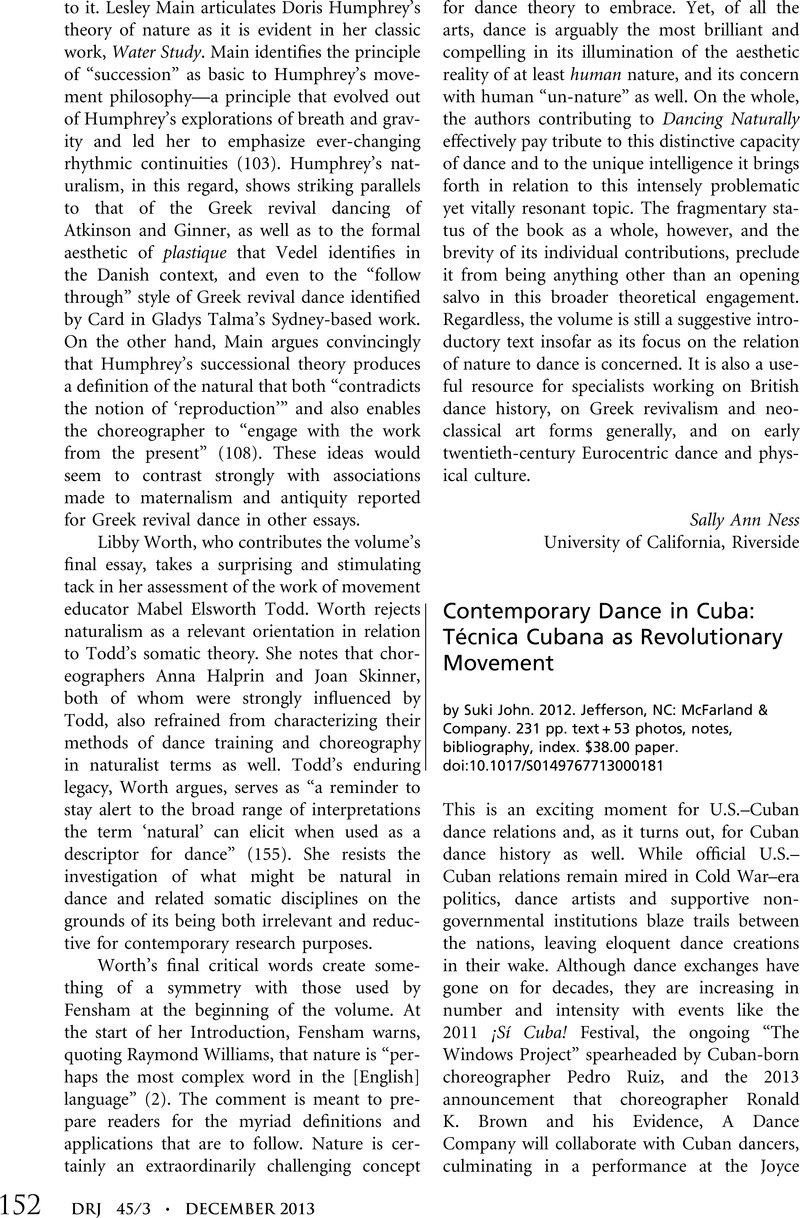No CrossRef data available.
Article contents
Contemporary Dance in Cuba: Técnica Cubana as Revolutionary Movement by Suki John. 2012. Jefferson, NC: McFarland & Company. 231 pp. text + 53 photos, notes, bibliography, index. $38.00 paper.
Published online by Cambridge University Press: 25 March 2014
Abstract
An abstract is not available for this content so a preview has been provided. Please use the Get access link above for information on how to access this content.

- Type
- Book Reviews
- Information
- Copyright
- Copyright © Congress on Research in Dance 2013
References
Works Cited
Brill, Deirdre. 2007. “La Escuela Cubana: Dance Education and Performance in Revolutionary Cuba.” PhD diss., University of Pennsylvania.Google Scholar
Burdsall, Lorna. 2001. More Than Just a Footnote: Dancing from Connecticut to Revolutionary Cuba. Montmagny, Québec: AGMV Marquis.Google Scholar
Daniel, Yvonne. 1995. Rumba: Dance and Social Change in Contemporary Cuba. Bloomington, IN: Indiana University Press.Google Scholar
De la Fuente, Alejandro. 2001. A Nation for All: Race, Inequality, and Politics in Twentieth-Century Cuba. Chapel Hill, NC: University of North Carolina Press.Google Scholar
Dopico Black, Georgina. 1989. “The Limits of Expression: Intellectual Freedom in Postrevolutionary Cuba.” Cuban Studies 19: 107–42.Google Scholar
Fernandes, Sujatha. 2006. Cuba Represent! Cuban Arts, State Power, and the Making of New Revolutionary Cultures. Durham, NC: Duke University Press.Google Scholar
Frederik, Laurie. 2012. Trumpets in the Mountains: Theater and the Politics of National Culture in Cuba. Durham, NC: Duke University Press.Google Scholar
Gleijeses, Piero. 2002. Conflicting Missions: Havana, Washington, and Africa, 1959–1976. Chapel Hill, NC: University of North Carolina Press.Google Scholar
Guerra, Lillian. 2012. Visions of Power in Cuba: Revolution, Redemption, and Resistance, 1959–1971. Chapel Hill, NC: University of North Carolina Press.Google Scholar
Guillermoprieto, Alma. 2004. Dancing with Cuba: A Memoir of the Revolution. Translated by Allen, Esther. New York: Vintage Books.Google Scholar
Hagedorn, Katherine. 2001. Divine Utterances: The Performance of Afro-Cuban Santería. Washington, DC: Smithsonian Institution Press.Google Scholar
John, Suki. 2007. “La tecnica cubana: A Revolution in Dance.” PhD diss., University of Connecticut.Google Scholar
Lumsden, Ian. 1996. Machos, Maricones, and Gays: Cuba and Homosexuality. Philadelphia, PA: Temple University Press.Google Scholar
Miller, Nicola. 2008. “A Revolutionary Modernity: the Cultural Policy of the Cuban Revolution.” Journal of Latin American Studies 40(4): 675–96.Google Scholar
Moore, Robin D. 2006. Music and Revolution: Cultural Change in Socialist Cuba. Berkeley, CA: University of California Press.Google Scholar
Mousouris, Melinda. 2002. “The Dance World of Ramiro Guerra.” In Caribbean Dance from Abakuá to Zouk: How Movement Shapes Identity, edited by Sloat, Susanna, 56–72. Gainesville, FL: University of Florida Press.Google Scholar
Sawyer, Mark Q. 2006. Racial Politics in Post-Revolutionary Cuba. New York, USA: Cambridge University Press.Google Scholar
Terry, Walter. 1981. Alicia and Her Ballet Nacional de Cuba. New York: Anchor Press/Doubleday.Google Scholar
Tomé, Lester. 2011. “The Cuban Ballet: Its Rationale, Aesthetics and Artistic Identity as Formulated by Alicia Alonso.” PhD diss., Temple University.Google Scholar
Viddal, Grete. 2012. “Vodú Chic: Haitian Religion and the Folkloric Imaginary in Socialist Cuba.” New West Indian Guide 86(3–4): 205–36.Google Scholar


